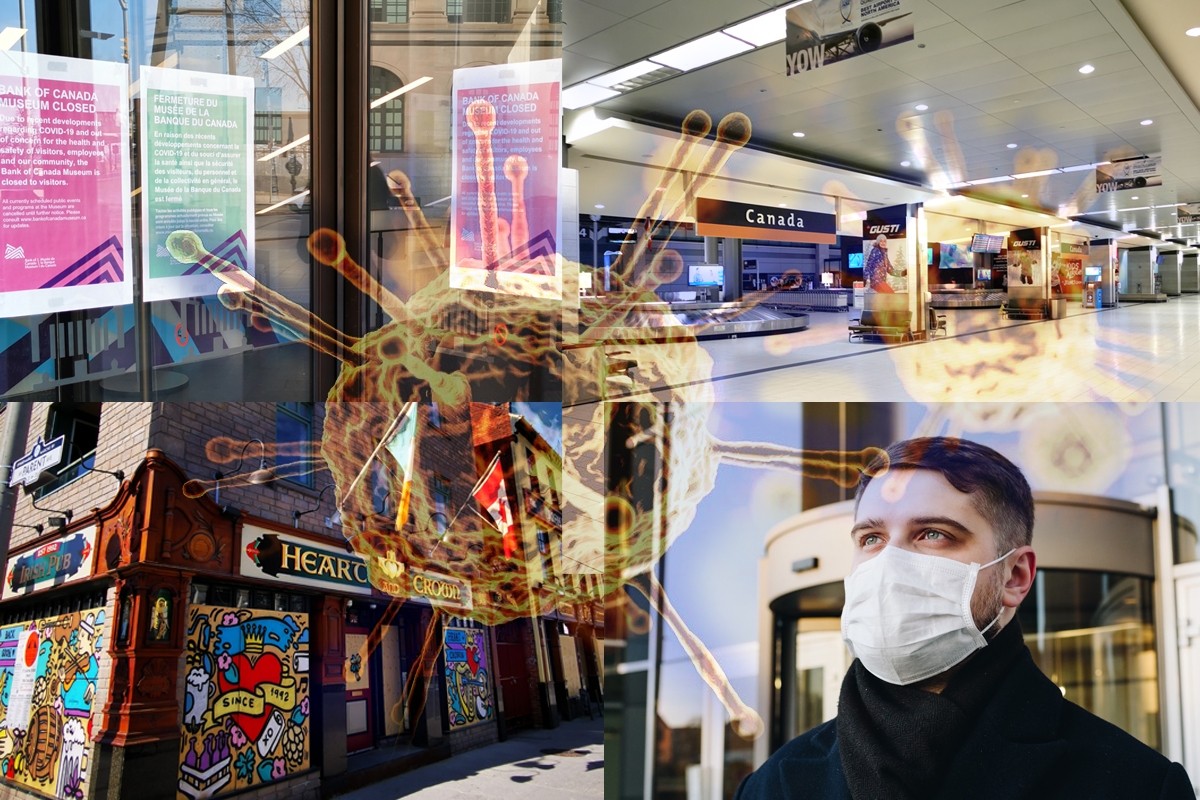
Covid-19: Reflections on the end game
Part 1: The Time Before a Vaccine
Now half way through 2020, having spent a few months with the drawbridge raised, most of us are becoming deeply curious about how the Covid-19 crisis ends. There have been flocks of somewhat superficial articles about how the world will be different after, with oodles of speculation about telework and changes in real estate values and travel patterns. But the portrait of the next 12 months has not been very finely drawn.
The lockdown roller-coaster: Some jurisdictions have been better than others at using lockdowns to blunt the rise in Covid-19 cases. The most effective have even reduced the numbers of active cases to such a low level that traditional public health techniques of identification and contact tracing can actually control the spread of infection. The less competent ones have merely converted what would have been an exponential rise in active cases into a linear one. In between these lie the majority of jurisdictions, which have produced a near steady state of a largish number of active cases, too many to use classical methods to finish off the job, but few enough to be tempted to stick their heads above the parapet again.
Some will over-do the relaxation of restrictions. The public needs to know that the easing up doesn’t mean its over. It only means that there’s room for you in the ICU. The titration of the opening up, both in timing and extent, has been better handled in some jurisdictions than others. We watch some parts of our southern neighbour in horror as ideology rather than science drives the speed, the extent, and the style of the re-opening. The roughly two-month lag between the return of incautious behaviour and very high death rates makes informed leadership even more critical.
Errors in failing to impose restrictions early enough, hard enough and long enough to restore the ability to use contact tracing and testing for the few remaining flare-ups arose in part from a facile but false early assumption that the restrictions were, in effect a balancing act between the risks to health and life on the one hand and doing economic harm on the other. This notion of a balancing act has been a mainstay of media coverage of the crisis, but it is unlikely to be true. It was based upon early, oversimplified short-term modeling. Such simplified modelling fails to cover the economic effects during the entire period till a vaccine becomes available, including repeated secondary lockdowns if the primary one was inadequate or interrupted too soon. It also fails to consider the long-term economic impact of impaired future health among many and the economic losses associated with myriad premature deaths. Furthermore, it neglects to take note of the cost of waiting too long before locking down, and further neglects losses during any extended recovery which follows the roller-coaster ride of repeated lockdowns. When more elaborate modelling methods are used that include these missing elements, the results tend to support the view that earlier and tougher measures reduce both the disease burden and the total economic cost.
It seems that we may now be in for a series of peaks and valleys where restrictions need to be re-imposed from time to time. But by now, at least in Canada, the public knows the drill, and each re-imposition is likely to be effective more quickly than the first time, and therefore not last as long. Improved widespread readily available testing for the virus and for antibodies will also help to get new outbreaks under control faster and with less damage.
The media have been unhelpful in another respect, because of their love affair with the term “second wave”. Their incessant speculation about whether or not there will be a “second wave” has been an enabler for the “let’s re-open fully” lobby. News flash: This is all still first wave, and will be for a long time. The first wave may have had the Monty Python foot dropped on it, but the modified first wave is still here.
The key to all management of Covid-19 in the period before there is a profound revolution in therapeutics or a vaccine for it is in managing the tricky little parameter called Ro.
The tweaking of Ro: Ro is the symbol for the rate at which Covid-19 infections multiply. It is not an inherent parameter of the virus, but rather a reflection of the interaction of the virus with the totality of behaviours of a given society. For our society as it was last January, various epidemiologists have estimated Ro to be 3.0-3.4, meaning that each case at that time gave rise on average to 3.0-3.4 new cases. But our moderate lockdown changed those dynamics, and seemed to drop Ro to about 0.6-0.8. This is important, as any sustained Ro below one will eventually see the disease die out, while any sustained Ro above one will see it rise. The amount above or below 1.0 determines the slope of the rise or fall of active case numbers.
The key to successful partial re-openings is to allow enough return to normalcy to allow people some freedom to get on with life without allowing Ro to exceed 1.0. This is a tricky calibration, and many jurisdictions will overshoot the 1.0, forcing new restrictions for a while. Nonetheless, a few factors are encouraging.
First of all, on average, behaviours are now more cautious than they were before the crisis. Yes, there are a non-trivial number of fools, knaves and simpletons, but most folk have developed some new infection avoidance reflexes that even if we did open up fully, which we won’t, the new Ro would likely be closer to 2.0 than to 3.0. That implies that a partial opening has a real chance of keeping Ro below 1.0 most of the time.
Another small factor in our favour is that, for a time at least, a handful of our neighbours may be immune. As I write this, less than a third of one percent of Canadians have tested positive for Covid-19, but few scientists believe that everyone who has been infected has been tested, given that some of those infected may experience either no symptoms or minor ones easily rationalized as something else. So it may well be that one or two percent of Canadians now represent a minor bulwark against the disease, in that, at least for now, they can’t get it or spread it. This is very far from any “herd immunity” concept, but it does tweak the effective Ro slightly downwards.
Progress in therapeutics for Covid-19: There is a vast array of work underway to identify and verify treatments for Covid-19. There have been a few successes amongst the horde of trials, experiments, and revisions of care practices.
A major thrust has been to identify likely candidates among existing drugs, and to try to ameliorate Covid-19 with this “off-book” use of them. While anecdotal small-scale studies hinted at many possibilities, so far there is only a degree of certainty about a few:
(a) Remdesivir, an anti-viral drug which is a nucleotide analog type antiviral, has been shown to shorten the course of the disease. It is still in short supply, is give intravenously over either 5 or 10 days, and is therefore given in hospital, so far only to quite ill patients. However, considering its mode of action, one would expect it to be even more useful if it could be given somewhat earlier in the course of the disease. I could imagine eventual outpatient administration of this drug.
(b) Dexamethasone, a glucocorticoid, is an anti-inflammatory, which, when given to the sickest patients (those being ventilated), appears to prevent about a third of the deaths. For patients receiving supplemental oxygen, but not on a ventilator, loss of life is reduced by about a fifth. This drug can only be used late in the course of the disease, at the point where the major risk is overreaction of ones own immune system, but when the original virus has already mostly cleared. If given too early, it would likely worsen the disease by enabling easier reproduction of the virus.
(c) In the most severely ill patients with Covid-19, the disease seems to trigger dangerous blood clots in many parts of the body. Anti-coagulants such as heparin are now being used to prevent the formation of these blood clots. How much of the mortality and morbidity of Covid-19 is due to this clotting is not yet entirely clear.
Another major thrust is the race to make brand new drugs to counter the virus. Amongst the most promising lines of work are the attempts to identify, test and mass-produce antibodies that could be injected into a patient to counter the virus until the patient’s own defences become fully engaged. One would not expect to see significant availability of such newly tailored antibodies until at least a few months from now.
And some gains are being made, boringly enough, by simply improving care. By way of example, less damaging ways of using ventilators show promise, as does a greater reliance on other, less drastic ways to improve oxygenation.
Dozens of clinical trials are due to be completed between now and October. They will likely produce some incremental improvements in treatment. But early progress reports from many of them do not hint at any spectacularly effective treatments.
Therapeutic improvements are a critical part of the struggle against Covid-19, but, in the period from now to the availability of a vaccine, they are unlikely to reduce the risk from this disease to the more familiar levels of seasonal influenza. Bear in mind that up to this point Covid-19 has been considerably easier to catch than the flu and possibly as much as twenty or thirty times as lethal for those that do get it. Therapeutics will help considerably, but a vaccine is the gold standard.
Part 2: Vaccines and beyond
Why a vaccine is a near-certainty: It has become commonplace for the media to interview medically-trained folk who intone things like, “There is no certainty that a vaccine can be made. After all, there have been no vaccines against other human coronaviruses.” Such a statement underscores the narrowness of their thought processes, and is almost certainly misleading.
Before SARS-CoV-2, the virus that causes Covid-19, there were only six known human coronaviruses. Four of these cause cold-like symptoms, and may be responsible for about a quarter of the minor illnesses we call colds. The other three quarters of colds are caused by rhinoviruses. Just imagine a researcher approaching a drug company and saying “Please invest hundreds of millions of dollars in development and validation of our proto-vaccine which can prevent up to 25% of colds”. You can guess the outcome. There is zero market for a vaccine which will prevent only a small fraction of a minor annoyance.
The other two previously known human coronaviruses are SARS and MERS. Outstanding work was done on candidate vaccines for both, but when it came time to move to Phase 2 trials, both diseases had been controlled. No phase 2 trial can possibly be done when you know in advance that the placebo will be just as effective as the vaccine in preventing the disease, because no-one is getting the disease anyhow. The work was recorded and shelved.
The brilliant work on those vaccines in fact became the foundation for the rapid work today on some of the candidate vaccines against Covid-19.
The role of economics and demand in vaccine creation, including vaccines for coronaviruses, can be seen most clearly if we look at the animal world. We know of over 30 animal coronaviruses, and there are eight of them for which vaccines are commercially available right now. The ones available now include vaccines for cats, dogs, pigs (2 different coronaviruses), cattle, chickens and turkeys. Unsurprisingly, there are as yet no vaccines for the coronaviruses that infect Asian leopard cats, antelopes, giraffes, bats, rats, mice, belugas and pangolins. Thus the obvious becomes clear. The existing vaccines for coronaviruses are the ones for which there was a real market, justifying their development.
A case could be made that the SARS-CoV-2 coronavirus may be somewhat more of a problem, as it is a beta-coronavirus, and all but three of the vaccines noted above are for alpha-coronaviruses. It is worth noting however, that the bovine coronavirus is a beta-coronavirus, and yet there is an available vaccine against it, since cattle are an economically important species. (The two avian coronavirus vaccines I mentioned are against gamma-coronaviruses).
I taught medical students for more than 15 years. I have enormous respect for their dedication and hard work. But many of them were so focussed on the great mass of material they needed to absorb that they had little time for learning about other fields. So when they later appear clueless about animal diseases and vaccines, or about economics, or many other fields of human endeavor, have some sympathy for what they missed between the ages of 21 and 27. But it does often make them less than perfect seers when it comes to some broad-spectrum human endeavor.
The expedited vaccine approval process: There has been concern expressed by some that vaccine approvals are being rushed, and that safety may be compromised as a result. These comments give succor to the conspiracy theorists and to the anti-vaccine movement (there is an overlap between them). In fact, quite the opposite is true. It is enormously likely that any vaccine produced for widespread use against Covid-19 will be one of the safest medications ever produced.
The vaccine approval process has been in sore need of an overhaul and some streamlining for at least 15 years, because it is an artifact of a time before many of the stunning developments of the past generation in molecular medicine.
Vaccine development traditionally was part science and part art, a bit like making beer. But today, with rapid sequencing of genetic materials, the ability to build biologically active materials from scratch, instead of growing them, and the ability to accurately assay minute amounts of biological substances, the vaccine building and testing process is considerably altered. Rather than working with the pathogenic virus, killed or weakened, most vaccines are now made either by placing a suitable sequence from the pathogen into a known harmless adenovirus, or by going the all-synthetic route by making a synthetic mRNA related to one tiny part of the pathogenic virus against which ones wishes to raise an immune response.
Many of these modern vaccine platforms are already so well known in terms of their effects on humans that animal trials can be truncated or skipped entirely. Furthermore, the phase 1 human trials, which are to demonstrate safety, rather than effectiveness, can also be used to collect precise data of the raising of appropriate antibodies in vivo, and thus can be logically added to phase 2 data. Similar eliding of phase 2 and 3 data is equally logical, given what can now be measured.
So the current move to streamline the vaccine approval processes in a number of developed nations is a triumph of logic over bureaucracy. A small bit of good fallout from a nasty crisis.
How good does a vaccine need to be? A vaccine against Covid-19 does not need to be an especially good one to defeat the pandemic. It just needs to be good enough to push the effective Ro (remember that term from Part 1) of the disease to anything less than 1.0. Given a modicum of good sense on the part of the population, a vaccine that protects anything over half the population would likely see the disease die out in a season. It is also likely that those in whom the vaccine did not entirely prevent infection would experience a much milder form of the disease than they would have otherwise.
It is also likely that more than one vaccine for Covid-19 will come to market in the next year or so. Given that there are over a hundred candidate vaccines, and that some 15 are moving along quite expeditiously, multiple approved vaccines may be inevitable. This is not a bad thing, in that different vaccines can block different steps of the infective process. The first vaccine may not be the most effective, but that should not cause people to wait for a better one. I usually explain this to folk in my age group by pointing out that even if they had the Zostavax vaccine for shingles (moderately effective), their doctors will still encourage them to get the now available two-shot Shingrix vaccine (very effective). One does not preclude the other.
It will go badly for the anti-vaccine lobby: The anti-vaccine movement has been enabled by social media. No surprise there, in that countless loopy fads have been so enabled. But up till now, its adherents have had a free ride, because objecting to established vaccines for long-present illnesses enabled them to hide behind the immunized majority. As vaccines for Covid-19 come on line, they will argue before the courts that they have the right to refuse inoculation, in the same way that they have the right to decline any medical treatment. And in this they will succeed.
The big disappointment will come when they find that a bunch of other things that they thought were rights are not seen by the law as rights, but as qualified privileges. Thus they may find that they cannot be accorded the privilege of working in a job that involves meeting the public. They may find that their children will need to be home-schooled. In highly litigious jurisdictions, like the US, they may experience civil liability for those they infect. But on the whole, it will be crucial to message precisely, accurately and compassionately in order to extend acceptance of the vaccines and to minimize the harm that such poorly informed folk will do to themselves and others.
What are the possible spin-offs from all this work on vaccines? There will be as yet unimagined future developments that will have had their genesis in the flood of science being done because of Covid-19, but one can certainly guess at three.
First, the new-found techniques for fast vaccine production will likely mean that the lowly annual flu shot will get better. At this point the guess as to which influenza strains to immunize against is made so far in advance that it’s often a poor guess. Going forward, that guess will only need to be made much closer to when the vaccine is needed than it is now, with the lag between the guess and the delivery being reduced by a half to two-thirds. That will make it a better guess. It’s like looking at a weather forecast. Are you more likely to believe the forecast for two days from now than you are for a week from now? You bet you are.
Secondly, generic vaccine platforms will have been developed that can quickly be adapted for use against new threats. With some investment, this could be the last pandemic, as we could see the lag times from identification of a pathogen to a vaccine shortened so much that the new pathogen never gets a real foothold.
Thirdly, it opens the door to using the new technologies for vaccinating against a number of common cancers, a notion that was already gaining traction in some scientific circles.
The shock waves from Covid-19 are far from over. The voyage to summer 2021 will be awkward and complicated. But when we get there it will be worth tallying not only what we’ve lost, but also what we’ve learned and what we’ve gained.









